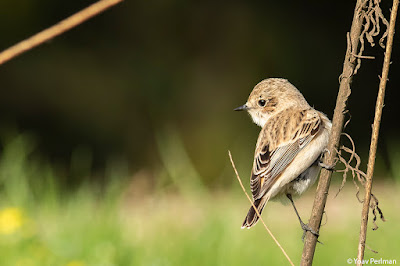As promised, here is a collection of photos I took of Yelkouan Shearwaters on Wednesday. I was standing at Palmahim and enjoying a fishing party, participated by hundreds of gulls and terns, and over 70 Yelkouan Shearwaters. As mentioned in the previous blogpost, this winter is special for Yelkouan Shearwaters. The numbers seen this winter are higher than average in recent decade or so - there have been many observations of large numbers, especially along the northern Mediterranean coast of Israel (check this eBird checklist by Itamar Donitza et al. for example). What's really unusual is the distance to shore. In normal years they are typically seen flying past at a fair distance from shore. This year they are often seen foraging very close to shore, giving fantastic opportunities to document them. This is what happened to me on Wednesday. The shearwaters joined the gull feeding flock, and were fishing very close to shore. Mostly around 40-50 m from shore, but some bolder individuals came as close as 20 m to shore. I have never seen anything like this in Israel before. I took close to 1000 photographs of them. I tried to document as much as I can the variation in their underwing and vent patterns. Besides the variation apparent in the intensity of darkness of axillaries, lesser coverts and vent; the impression of underwing pattern also depends on light conditions and angle. Additionally, I was also hoping to find a rarer shearwater among them, without success. I selected few photos to present here.
Sunday, January 30, 2022
Yelkouan Shearwater party
Friday, January 28, 2022
Seawatching
Wednesday morning I visited Palmachim beach. A large storm was boiling, the wind was already good, the sea was properly rough - just before the rain started at noon.
When I arrived at the seawatching spot, I was greeted by a sea full of birds:
There was really good activity of gulls close to shore, attracted to large fish shoals. Soon I noticed that there were good numbers of Yelkouan Shearwaters among the gulls, feeding very close to shore, sometimes down to 20m. Fantastic. This winter is special for yelkouans - their numbers are bigger than usual in recent years, and they are often seen feeding very close to shore. I focused most of my attention on the shearwaters, and took many hundreds of photos of them. I was hoping to find another shearwater among them (which I didn't), and document their variation. I also really enjoyed watching them fish, using short dives. It was difficult to digiscope in these conditions...
I will devote a separate blogpost to the Yelkouan Shearwaters - out of the hundreds of photos I took a few tens are blog-worthy. I will leave you with one I am pleased of.
The gulls were dominated by Black-headed Gulls, but there were a few other gulls mixed in, though the diversity was fairly low.
Many Sandwich Terns were fishing close in too:
One Pomarine Skua passed two distantly for a photo, but two Arctic Skuas made near passes - one super close. The first bird is especially small (check the size comparison with Black-headed Gull!), but still an Arctic.
Monday, January 10, 2022
Siberia and South America
2021 ended with a bang, and 2022 started in a very different tempo. First, I made a sort of new year resolution, not to do another Big Year. After two years in a row, I think I had enough. My family needs me back, and I need to invest more in my new position at work. Also, with the bird flu outbreak here (see recent articles in National Geographic and BirdLife International website), I am really very very busy. I am maintaining my checklist streak (880 days today), which leads me to 'rediscover' my local birding sites, those that can be combined with school run and dog walk. In 2021, as a result of me being all over, I neglected my local birding. So this return to the basics is welcome, at least for now, until I get itchy again...
January perhaps isn't the most dynamic month of the year, but there's still plenty to see locally. Especially on days with lovely sunshine, like today was, birds are singing, everything looks very lush and green, and it's so pleasant to be outdoors. This morning's birding along Nahal Ekron produced the expected stuff (eBird checklist here). It's a good winter for Siskin, and several small groups flew by, as they do every day here this winter. The small seasonal wetland at the western section holds water and ducks, which is nice. Interestingly, two Siberian Stonechats took up winter residence here, separately. They are common enough autumn migrants but pretty uncommon in winter. They are holding small territories about 1 km from each other. The male is a maurus-type, haven't managed to get a photo of him yet. The female, no idea what her taxon is, is more tolerant to humans as its territory is right on a main and busy footpath, adjacent to housing estates, very popular with dog walkers, runners, cyclists etc. I spent a few minutes with it this morning. At first perhaps my attention made her quite nervous. However, after few minutes, she lost interest in me and went on with her stuff, i.e. catching bugs. Lovely little bird.













































